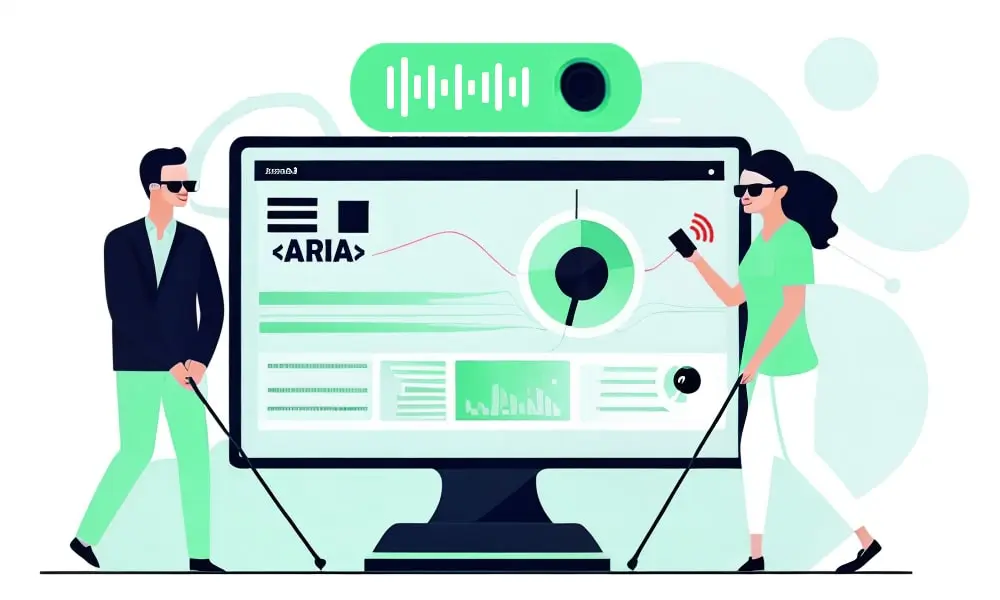
ARIA, short for Accessible Rich Internet Applications, is a set of special coding instructions that enhances accessibility for people with disabilities. These instructions, called attributes, are added to standard HTML elements on a webpage.
Imagine a website with a fancy button made from a simple image instead of the built-in HTML button. Someone using a screen reader wouldn’t know it’s a button! ARIA attributes can be added to this image to tell the screen reader it’s a button and how to interact with it.
In a nutshell, ARIA bridges the gap between what a webpage can naturally communicate and what assistive technologies, like screen readers, need to understand. This allows users with disabilities to navigate and interact with web pages just as easily as anyone else.
While ARIA is powerful, it’s always best to use standard HTML elements whenever possible. Think of ARIA as a toolbox for situations where standard HTML can’t handle the job, making the web a more inclusive and accessible space for everyone.
So, buckle up and get ready to see how ARIA transforms websites from one-dimensional experiences to bustling, accessible havens!
How can ARIA be used to make web content more accessible?
ARIA (Accessible Rich Internet Applications) is a powerful tool for web developers to enhance the accessibility of their creations. By leveraging ARIA attributes, websites can become more usable for people with disabilities, ensuring an inclusive web experience for everyone. Let’s delve into how ARIA can be used to make web content more accessible through two key approaches:
Making Web Content Accessible with ARIA: Labels and Relationships
Accessible Rich Internet Applications (ARIA) empower developers to enhance web accessibility, especially for dynamic content and interactive elements. Here’s how ARIA tackles two key aspects: descriptive labels and relationships between elements.
Descriptive Labels:
Imagine a visually impaired user relying on a screen reader. ARIA attributes like aria-label and aria-labelledby come into play. With aria-label, you can directly attach text labels to any element, providing clear context for screen readers. For instance, a simple icon might be unclear without a label. Adding aria-label="Settings" clarifies its purpose. Similarly, aria-labelledby establishes a relationship between an element and an existing HTML element with text content (like a heading) that describes it. This way, the screen reader reads the descriptive text instead of announcing the element itself.
Creating Relationships Between Elements:
ARIA offers a rich set of attributes to define relationships between various web page elements. This improves navigation and user experience for those using assistive technologies. Here’s how:
- Landmark Roles:
ARIA allows assigning specific roles to sections of a webpage using role attributes. Common roles include banner (header), main (content area), and navigation. Screen readers can then announce these landmarks, allowing users to jump to specific sections efficiently.
- Live Regions:
Content updates can be a challenge for screen readers. ARIA’s aria-live attribute identifies dynamic content regions that change frequently. Screen readers can then announce these updates, keeping users informed.
By incorporating descriptive labels and relationships between elements using ARIA, developers can bridge the gap between web content and assistive technologies. This ensures everyone has an equally accessible and enjoyable web experience.
Remember: Always prioritize native HTML semantics before resorting to ARIA. And, ensure proper implementation to avoid introducing accessibility errors.
Making forms more accessible
Accessible forms are crucial for an inclusive user experience. They ensure everyone, regardless of ability, can navigate and complete forms with ease. This includes users with visual impairments, motor limitations, or cognitive disabilities.
One important tool in the accessibility toolbox is ARIA (Accessible Rich Internet Applications). ARIA provides additional information and semantics to web elements, making them more interpretable for assistive technologies like screen readers.
However, ARIA isn’t a magic bullet. It’s meant to enhance existing accessibility features, not replace them. Here’s a breakdown of when to consider using ARIA for forms:
When ARIA Shines:
-
Complex widgets: ARIA helps with custom widgets or interactions that lack standard HTML elements. For instance, a date picker built from scratch might leverage ARIA to communicate its functionality to screen readers.
-
Dynamic content: If your form content updates dynamically using Javascript, ARIA can help screen readers stay informed about these changes.
-
Disabling native functionality: ARIA can be used when you need to disable a standard HTML element’s behavior but still want to convey its purpose.
Focus on Core Accessibility First:
-
Clear labeling: Always use
<label>elements to associate text labels with their corresponding form controls. This is essential for screen readers and keyboard navigation. -
Semantic HTML: Utilize HTML elements that inherently convey meaning. For example, use
<input type="text">for text fields and<button>for buttons. Screen readers understand these elements by default. -
Error handling: Provide clear and informative error messages to guide users toward correcting their input.
ARIA for Enhancement:
By following these core principles, you lay a strong foundation for accessible forms. ARIA then serves as an additional layer to enrich the user experience for assistive technologies.
Remember, use ARIA judiciously. If there’s a standard HTML way of achieving accessibility, that’s the preferred approach. ARIA is for those specific scenarios where standard methods fall short.
5 Rules for Using ARIA Effectively
Here are 5 essential rules to remember:
-
Native HTML First:
This is the golden rule of ARIA. Always prioritize using standard HTML elements and attributes to convey meaning whenever possible. These elements are already understood by assistive technologies, reducing the need for additional ARIA markup. For instance, use an<input type="checkbox">instead of a<div role="checkbox">. -
Choose the Right Attribute:
If native HTML semantics aren’t sufficient, ARIA attributes come in. But with a variety of attributes available, selecting the right one is crucial. Identify the specific functionality you want to convey and choose the most appropriate ARIA attribute for that purpose. -
Accuracy is Key:
The information you provide through ARIA attributes needs to be accurate and complete. Assistive technologies rely on this information to represent the content to users. Inaccurate descriptions can be confusing and hinder usability. -
ARIA with Semantics:
ARIA works best when used in conjunction with semantic HTML. Semantic HTML elements inherently convey meaning about the content they contain. ARIA attributes can then enhance this meaning or provide additional details for elements that lack well-defined semantics. This creates a strong foundation for assistive technologies to work with. -
Assistive Technology Compatibility:
Not all ARIA attributes are supported by every assistive technology. Consider the target audience and the most commonly used assistive technologies when choosing ARIA attributes. There’s no point in using an advanced attribute if it’s not understood by the primary assistive technologies your users rely on.
By following these rules, you can ensure that ARIA is used effectively to create a more inclusive and accessible web experience for everyone.
The Bottom Line
ARIA has emerged as a game-changer in the realm of web accessibility. By bridging the gap between standard web content and the needs of assistive technologies, ARIA empowers users with disabilities to navigate and interact with websites seamlessly.
Remember, ARIA functions best as a supporting act, not the main star. Always prioritize the use of native HTML elements and semantics whenever possible. ARIA should be reserved for those instances where standard HTML falls short.
By following the core principles outlined here, web developers can harness the power of ARIA to craft websites that are not only visually appealing but also universally accessible. This ensures a richer and more inclusive web experience for everyone, regardless of ability.


Share Your Thoughts
Comments on “ARIA in Action: Showcasing Examples of Accessible Websites”